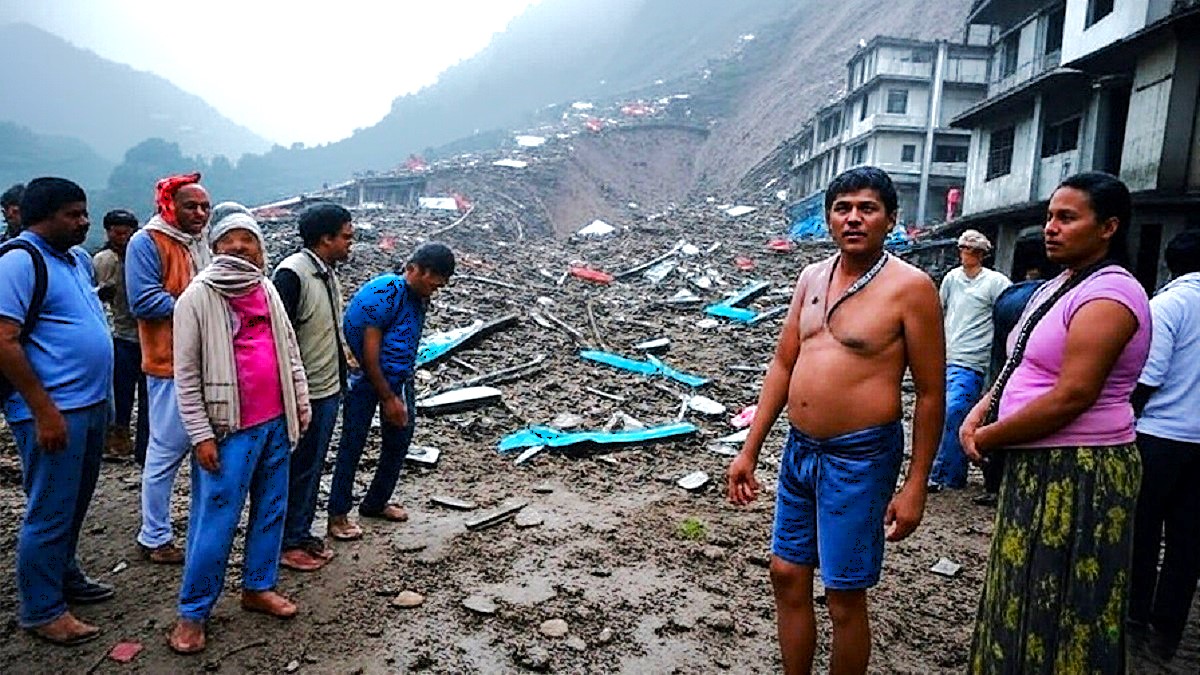Vaishno Devi landslide 2025 turned a sacred journey into a tragedy when over 30 pilgrims were killed en route to the shrine. In this blog, we unpack how excessive monsoon rains, slope instability, and safety gaps converged to unleash disaster—and what must change to protect future yatras.
On 27 August 2025, tragedy struck the pilgrimage route to the revered Vaishno Devi shrine in Jammu & Kashmir: a massive landslide on the trekking path near Ardhkuwari (about halfway along the 12-km route) buried pilgrims and killed dozens. The region had been battered by unusually heavy monsoon rains; the landslide came as rescue teams raced to reach stranded devotees and hospitals readied to receive casualties. This blog breaks down the incident, the immediate rescue response, who was affected, likely causes, and practical safety reforms that must follow.
The facts on the ground — what happened
According to multiple reports and live updates from local officials, a hillside gave way around mid-afternoon near Adhkuwari (also spelled Ardhkuwari) on the Vaishno Devi trail, sending boulders, mud and debris crashing onto pilgrims below. Initial counts put the death toll in the 30–33 range and dozens injured, though figures were still evolving as rescue teams combed the site. Authorities immediately suspended the yatra and halted train services to Katra while relief operations began.
Human toll — who were the victims?
The Vaishno Devi route sees devotees from across India year-round; during festival periods or spells of good weather the trail carries thousands daily. Those affected in this landslide were ordinary pilgrims—families, elderly devotees, and groups traveling together. Hospitals in Katra and nearby towns received the injured, while some critically wounded were transferred to larger facilities for advanced care. Local officials and state government sources confirmed multiple fatalities and a continuing search for any persons feared trapped under debris.
Weather & environment — why the slopes failed
Meteorological data and on-the-ground reporting point to heavy, persistent rainfall across Jammu & Kashmir as the immediate trigger. In the days leading up to the landslide, the region recorded intense rainfall rates—overnight downpours and localized cloudbursts—which saturated soils, undermined slope stability, and increased the chance of rockfalls. Rivers in the wider Jammu region had risen, bridges were damaged in some areas, and flood alerts were active across multiple districts. When slopes are waterlogged, even relatively small triggers (heavy runoff, a saturated talus, or human disturbance) can lead to catastrophic failure.
Rescue operations — speed, scale and challenges
Within hours of the slide, local police, state disaster response teams, NDRF units and civil society volunteers were at the scene. Rescue teams faced a difficult terrain strewn with large boulders, mud and broken temporary structures that former pilgrims and porters had erected. Limited road access to the trailhead and interrupted communications due to weather hampered coordination. Still, teams used heavy excavators where possible, manual search lines, and K9 units to find survivors; ambulances ferried the wounded to hospitals. The scale of rainfall and the instability of remaining slopes demanded caution—rescuers also had to manage the risk of secondary slides.
Government response & official statements
State authorities declared relief measures and ordered an immediate suspension of the pilgrimage until it was safe to resume. Rail and road services to Katra were temporarily halted or rerouted to prioritize evacuation and relief logistics. National leaders expressed condolences and directed that all possible assistance be extended to the victims and their families. Local administrations set up emergency control rooms and coordinated with hospitals to ensure beds and blood supplies were available.
Why this is not just a ‘natural disaster’ — human factors matter
While extreme rainfall triggers landslides, human factors often magnify risk along pilgrim routes:
- Trail development and temporary structures: Small shops, tin sheds, and informal shelters built on or below slopes can change water flow patterns and add weight to vulnerable areas.
- Inadequate slope protection: Not all stretches of the 12-km Vaishno Devi trek have modern slope stabilization measures (retaining walls, drainage galleries, rockfall fences).
- High footfall exposure: The sheer density of pilgrims during peak periods increases exposure time in hazardous zones.
- Early-warning gaps: Localized slope-stability monitoring and real-time alerts for sudden weather changes were limited, reducing lead time to clear paths.
Addressing these human-made vulnerabilities must accompany climate and weather preparedness.
Immediate reforms that can save lives
- Accelerate slope stabilization works: Install retaining structures, rock-mesh, and catch-fences on identified high-risk sections. Prioritise areas with thin topsoil and historical slides.
- Real-time monitoring & early warnings: Deploy simple sensor networks—rain gauges, ground-movement inclinometers, and CCTV—to trigger automated closures of sections when thresholds are breached.
- Controlled access during extreme weather: Enforce temporary closures of the yatra during red/yellow weather alerts and ensure pilgrims are informed via SMS/announcements.
- Formalise safe shelter & evacuation points: Build robust, licensed rest points away from active slope faces that can be used during sudden storms.
- Community & volunteer training: Local porters, guides and resident volunteers should receive basic search-and-rescue and first-aid training to act in the first golden hours.
- Infrastructure audits & mapping: A publicly accessible risk map that flags hazard zones, safe detours, and helipad points would help planners and devotees alike.
Implementing these measures will require investment, political will, and active involvement of the Shrine Board, state agencies, and local communities.
Longer-term resilience — climate trends and pilgrim planning
Climate models show that as the monsoon becomes more erratic, mountain regions can experience intense, localized downpours—events that dramatically raise landslide risk. Pilgrim management must therefore integrate climate resilience: redesigning paths, enforcing seasonal limits, and building redundancy into transport and emergency logistics so that a single weather event does not overwhelm the system.
Final words — grief, action, and accountability
The Vaishno Devi landslide is a heartbreaking reminder that sacred places and spiritual journeys can be vulnerable to climate-driven hazards. Our compassion must extend beyond condolences: it must translate into concrete action—upgrading infrastructure, strengthening early warnings, enforcing safety rules, and ensuring swift, compassionate support for victims’ families. As rescue teams continue their work, the long road ahead will be about rebuilding not only paths and shelters, but trust—so pilgrims can once again make their journey with safety, dignity and peace of mind.
FAQs massive landslide in Vaishno Devi shrine in Jammu & Kashmir
A: Early reports placed the toll around 30–33 people, with dozens more injured; numbers were still being updated as rescue operations continued.
A: Near Adhkuwari (Ardhkuwari), roughly midway on the 12-km trek to the Vaishno Devi cave shrine.
A: Authorities temporarily suspended pilgrim movement and rail services to Katra to prioritise rescue and evacuation.
A: Heavy, prolonged rainfall that saturated the slope and triggered a catastrophic failure; secondary human factors (trail infrastructure, drainage) likely worsened impacts.









